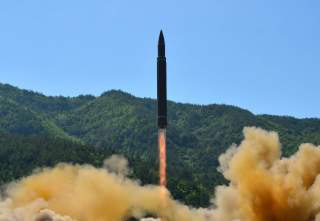Los Angeles, Destroyed: 378,000 People Would Die if North Korea Nuked LA
What would an actual nuclear exchange between the United States and North Korea look like? How many civilians would be killed? How much of Pyongyang or Los Angeles would be pulverized in a nuclear ash cloud? And how devastating would the nuclear fallout be to the suburbs in neighborhoods five, ten, or twenty, twenty miles away?
According to the metrics, the final casualty toll from a single nuclear device going off: 378,800 killed and 861,210 people injured—an estimated 1.2 million casualties. To put that number in perspective, this is more than two and a half times the casualty rate the U.S. military suffered during World War II. It’s a stunning number, and it would plunge the United States into a dark new chapter in its history—beyond anything that we as Americans have experienced before. If you thought the United States was engaged in an intense period of fear, depression, and self-introspection in the months and years following the September 11 terrorist attacks, then imagine what Washington’s reaction would be if a good portion of a premier American city were leveled to the ground.
What would an actual nuclear exchange between the United States and North Korea look like? How many civilians would be killed? How much of Pyongyang or Los Angeles would be pulverized in a nuclear ash cloud? And how devastating would the nuclear fallout be to the suburbs in neighborhoods five, ten, or twenty, twenty miles away?
(This first appeared in late 2017.)
Notwithstanding President Donald Trump’s rhetoric about unleashing “fire and fury” on North Korea—rhetoric that has made lawmakers in Washington so nervous that some have been compelled to introduce bills prohibiting a preemptive nuclear strike—the administration understands that even a single nuke flying in either direction would be calamitous. Defense Secretary Jim Mattis and Chairman of the Joint Chiefs of Staff Gen. Joseph Dunford, the top civilian and military defense officials in the country, have tried to bring people down from the ledge by reminding everyone of how “horrific” such a war would be—even one that didn’t include nuclear weapons.
Recommended: 8 Million People Could Die in a War with North Korea
How horrific, however, has been up for debate. While most agree that hundreds of thousands and potentially millions would die, the toll could be twice or maybe three times larger if either Washington or Pyongyang were to deploy their nuclear arsenals in a conflict. Alex Wellerstein, a professor at the Stevens Institute of Technology, has built a website that uses an algorithm that attempts to quantify the nuclear horror that thus far we can only imagine. So, the purveyor of doom I am, I typed in “downtown Los Angeles” as the site of a hypothetical North Korean nuclear weapons attack with a 250 kiloton nuclear weapon—the same estimated strength that the analysts at John Hopkins University’s School of Advanced International Studies’ 38 North delivered after Pyongyang’s sixth nuclear test this September.
Recommended: Why North Korea Is Destined to Test More ICBMs and Nuclear Weapons
While the results spit out of the algorithm certainly aren’t exact, they do provide the nuclear layman, like myself, with some easy statistics. The results are apocalyptic for the residents of Los Angeles County.
Downtown Los Angeles would be wiped out, eviscerated off the face of the map, never to be seen in the same way again. Dodger Stadium would be a pile of nuclear rubble. The campus of the University of Southern California, that prestigious institution that used to have the good football team, would be wiped out. The nuclear fallout of the 250 kiloton blast would cover Koreatown, with its residents covered in third degree burns if they were fortunate enough not to be killed first. Chinatown, closer to the downtown area, would fare even worse.
Recommended: 5 Most Powerful Aircraft Carriers, Subs, Bombers and Fighter Aircraft Ever
Tourists who may be visiting the Natural History Museum of Los Angeles County for the day, southwest of USC, would be rushed to the panicked, overworked and disorderly hospitals already streaming with patients, covered in third-degree burns that damage the nerves—assuming, of course, that the hospital wasn’t downtown. If you happened to be in the northeast quadrant of the museum during the attack, however, you might be buried underneath a pile of steel and concrete.
According to the metrics, the final casualty toll from a single nuclear device going off: 378,800 killed and 861,210 people injured—an estimated 1.2 million casualties. To put that number in perspective, this is more than two and a half times the casualty rate the U.S. military suffered during World War II. It’s a stunning number, and it would plunge the United States into a dark new chapter in its history—beyond anything that we as Americans have experienced before. If you thought the United States was engaged in an intense period of fear, depression, and self-introspection in the months and years following the September 11 terrorist attacks, then imagine what Washington’s reaction would be if a good portion of a premier American city were leveled to the ground.
Fortunately, all of this doom-and-gloom is still pure fiction. Whether it stays that way will depend on the calculations of President Donald Trump, who relishes being unpredictable and is quick to poke his enemies in the eye with tweet barrages, and Kim Jong-un, a paranoid sociopath whose number one fear is—and has always been—being deposed in a U.S. military operation.
Daniel DePetris is a fellow at Defense Priorities.
Image: Reuters
Recommended:
This Video Shows What Happens if Washington, D.C. Is Attacked with Nuclear Weapons

